Analysis of Metal Foams: Properties, Applications, and Challenges
VerifiedAdded on 2022/09/17
|22
|6956
|23
Report
AI Summary
This report provides a comprehensive overview of metal foams, materials with low density and unique mechanical, physical, and electrical properties. It explores various aspects including manufacturing methods, such as gas injection, and indirect foaming of precursors. The report highlights the significance of aluminum foam and silicon carbide, analyzing their role in foam stabilization. It delves into the research rationale, emphasizing the importance of metal foams in engineering and their potential to reduce the pressure on metal ores. The report outlines the aim, objectives, and research questions, focusing on the impact, challenges, and mitigation strategies related to using metal foams in engineering applications. A literature review is conducted, covering structural properties, thermal conductivity, and the use of various materials in foam metal structures. The report also touches upon the application of metal foams in electronic equipment, providing a detailed analysis of the current research and its relevance to the field of material science.
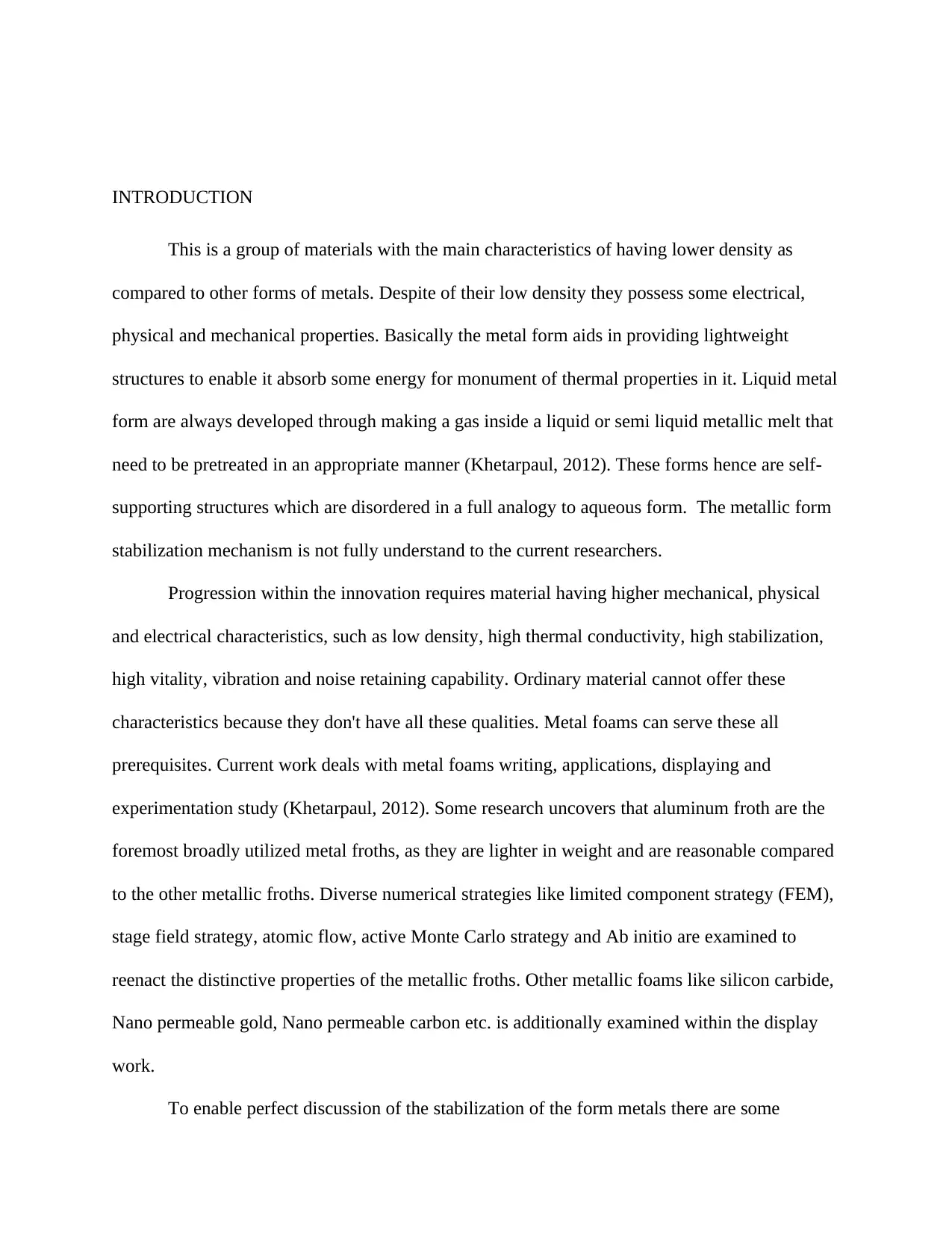
INTRODUCTION
This is a group of materials with the main characteristics of having lower density as
compared to other forms of metals. Despite of their low density they possess some electrical,
physical and mechanical properties. Basically the metal form aids in providing lightweight
structures to enable it absorb some energy for monument of thermal properties in it. Liquid metal
form are always developed through making a gas inside a liquid or semi liquid metallic melt that
need to be pretreated in an appropriate manner (Khetarpaul, 2012). These forms hence are self-
supporting structures which are disordered in a full analogy to aqueous form. The metallic form
stabilization mechanism is not fully understand to the current researchers.
Progression within the innovation requires material having higher mechanical, physical
and electrical characteristics, such as low density, high thermal conductivity, high stabilization,
high vitality, vibration and noise retaining capability. Ordinary material cannot offer these
characteristics because they don't have all these qualities. Metal foams can serve these all
prerequisites. Current work deals with metal foams writing, applications, displaying and
experimentation study (Khetarpaul, 2012). Some research uncovers that aluminum froth are the
foremost broadly utilized metal froths, as they are lighter in weight and are reasonable compared
to the other metallic froths. Diverse numerical strategies like limited component strategy (FEM),
stage field strategy, atomic flow, active Monte Carlo strategy and Ab initio are examined to
reenact the distinctive properties of the metallic froths. Other metallic foams like silicon carbide,
Nano permeable gold, Nano permeable carbon etc. is additionally examined within the display
work.
To enable perfect discussion of the stabilization of the form metals there are some
This is a group of materials with the main characteristics of having lower density as
compared to other forms of metals. Despite of their low density they possess some electrical,
physical and mechanical properties. Basically the metal form aids in providing lightweight
structures to enable it absorb some energy for monument of thermal properties in it. Liquid metal
form are always developed through making a gas inside a liquid or semi liquid metallic melt that
need to be pretreated in an appropriate manner (Khetarpaul, 2012). These forms hence are self-
supporting structures which are disordered in a full analogy to aqueous form. The metallic form
stabilization mechanism is not fully understand to the current researchers.
Progression within the innovation requires material having higher mechanical, physical
and electrical characteristics, such as low density, high thermal conductivity, high stabilization,
high vitality, vibration and noise retaining capability. Ordinary material cannot offer these
characteristics because they don't have all these qualities. Metal foams can serve these all
prerequisites. Current work deals with metal foams writing, applications, displaying and
experimentation study (Khetarpaul, 2012). Some research uncovers that aluminum froth are the
foremost broadly utilized metal froths, as they are lighter in weight and are reasonable compared
to the other metallic froths. Diverse numerical strategies like limited component strategy (FEM),
stage field strategy, atomic flow, active Monte Carlo strategy and Ab initio are examined to
reenact the distinctive properties of the metallic froths. Other metallic foams like silicon carbide,
Nano permeable gold, Nano permeable carbon etc. is additionally examined within the display
work.
To enable perfect discussion of the stabilization of the form metals there are some
Paraphrase This Document
Need a fresh take? Get an instant paraphrase of this document with our AI Paraphraser
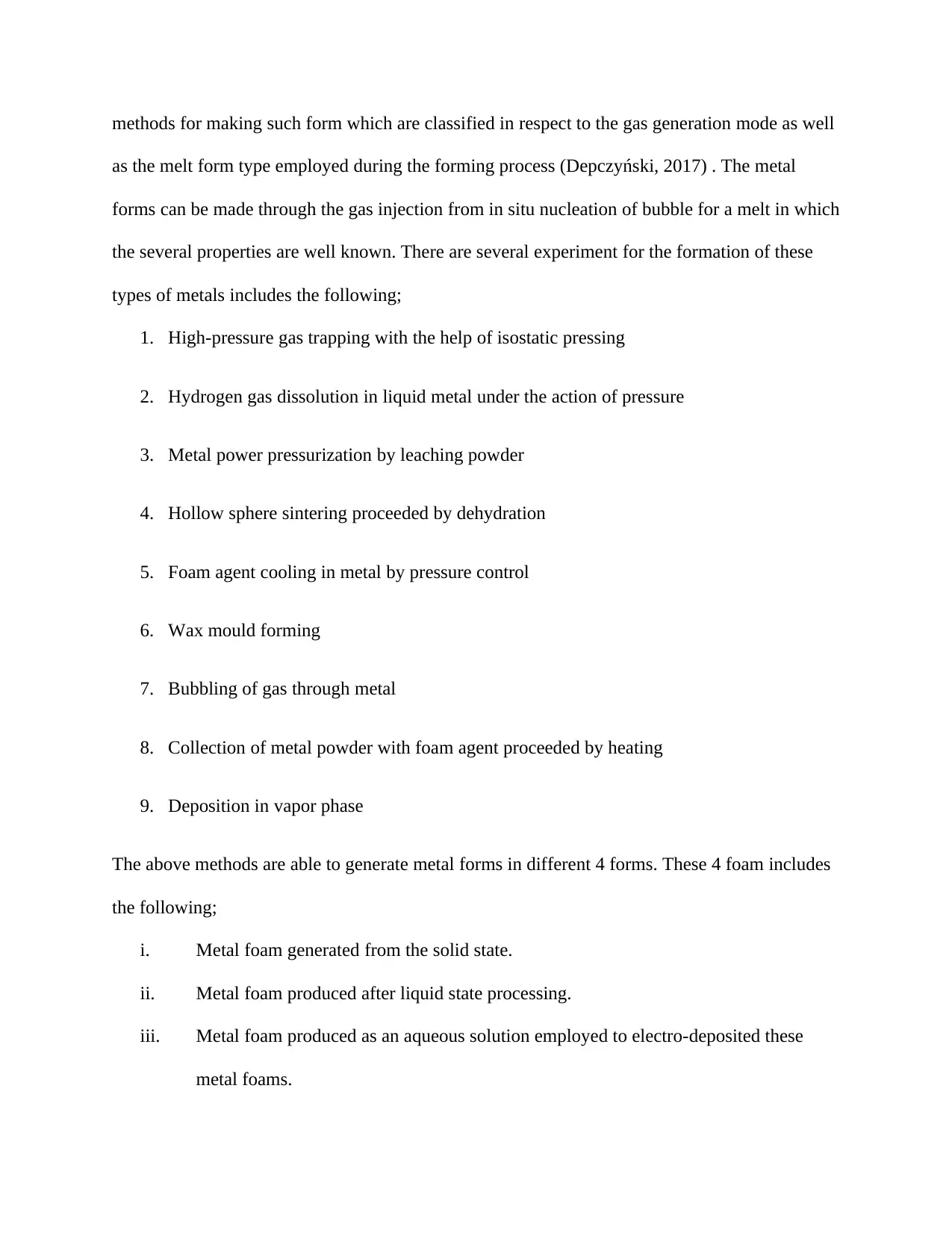
methods for making such form which are classified in respect to the gas generation mode as well
as the melt form type employed during the forming process (Depczyński, 2017) . The metal
forms can be made through the gas injection from in situ nucleation of bubble for a melt in which
the several properties are well known. There are several experiment for the formation of these
types of metals includes the following;
1. High-pressure gas trapping with the help of isostatic pressing
2. Hydrogen gas dissolution in liquid metal under the action of pressure
3. Metal power pressurization by leaching powder
4. Hollow sphere sintering proceeded by dehydration
5. Foam agent cooling in metal by pressure control
6. Wax mould forming
7. Bubbling of gas through metal
8. Collection of metal powder with foam agent proceeded by heating
9. Deposition in vapor phase
The above methods are able to generate metal forms in different 4 forms. These 4 foam includes
the following;
i. Metal foam generated from the solid state.
ii. Metal foam produced after liquid state processing.
iii. Metal foam produced as an aqueous solution employed to electro-deposited these
metal foams.
as the melt form type employed during the forming process (Depczyński, 2017) . The metal
forms can be made through the gas injection from in situ nucleation of bubble for a melt in which
the several properties are well known. There are several experiment for the formation of these
types of metals includes the following;
1. High-pressure gas trapping with the help of isostatic pressing
2. Hydrogen gas dissolution in liquid metal under the action of pressure
3. Metal power pressurization by leaching powder
4. Hollow sphere sintering proceeded by dehydration
5. Foam agent cooling in metal by pressure control
6. Wax mould forming
7. Bubbling of gas through metal
8. Collection of metal powder with foam agent proceeded by heating
9. Deposition in vapor phase
The above methods are able to generate metal forms in different 4 forms. These 4 foam includes
the following;
i. Metal foam generated from the solid state.
ii. Metal foam produced after liquid state processing.
iii. Metal foam produced as an aqueous solution employed to electro-deposited these
metal foams.
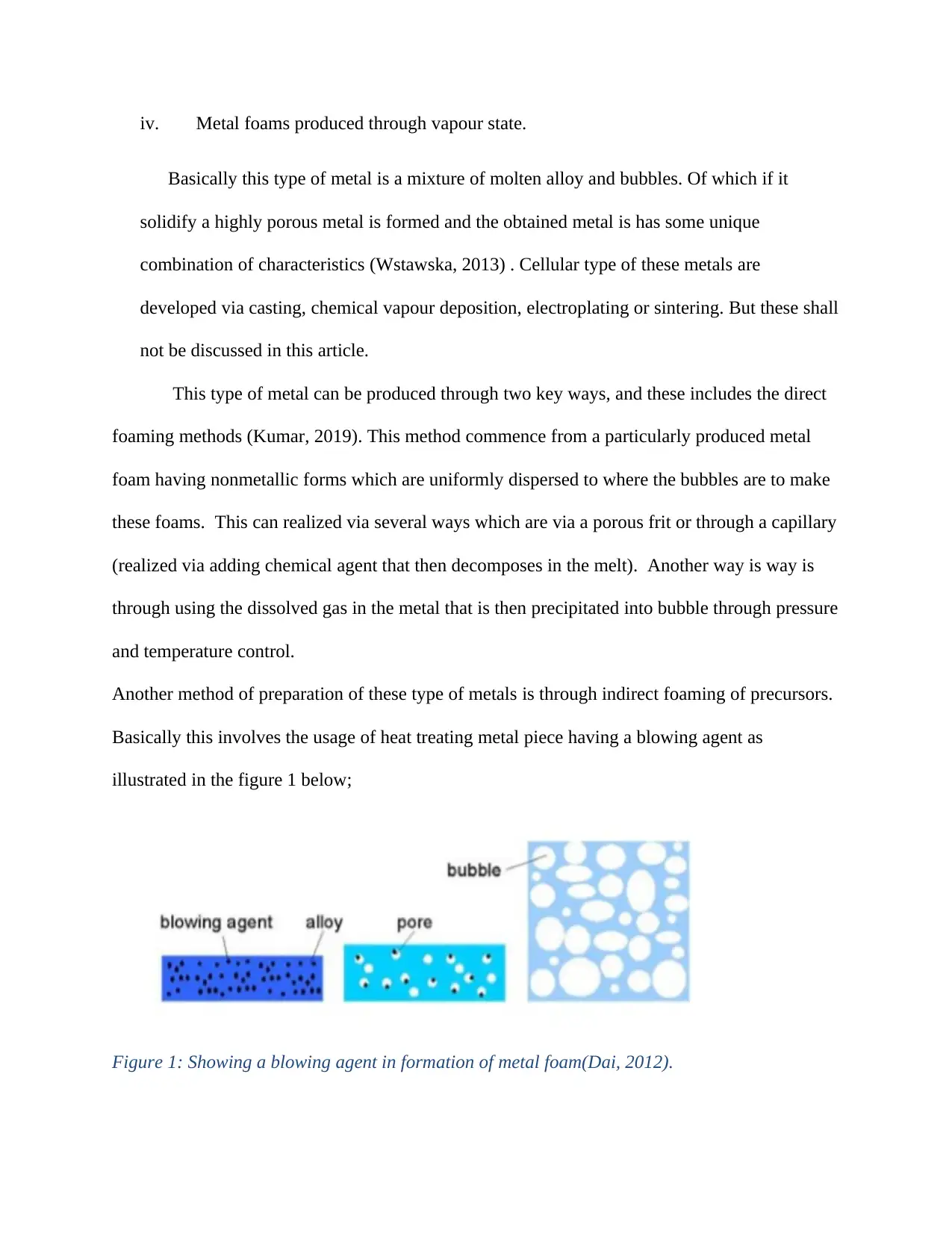
iv. Metal foams produced through vapour state.
Basically this type of metal is a mixture of molten alloy and bubbles. Of which if it
solidify a highly porous metal is formed and the obtained metal is has some unique
combination of characteristics (Wstawska, 2013) . Cellular type of these metals are
developed via casting, chemical vapour deposition, electroplating or sintering. But these shall
not be discussed in this article.
This type of metal can be produced through two key ways, and these includes the direct
foaming methods (Kumar, 2019). This method commence from a particularly produced metal
foam having nonmetallic forms which are uniformly dispersed to where the bubbles are to make
these foams. This can realized via several ways which are via a porous frit or through a capillary
(realized via adding chemical agent that then decomposes in the melt). Another way is way is
through using the dissolved gas in the metal that is then precipitated into bubble through pressure
and temperature control.
Another method of preparation of these type of metals is through indirect foaming of precursors.
Basically this involves the usage of heat treating metal piece having a blowing agent as
illustrated in the figure 1 below;
Figure 1: Showing a blowing agent in formation of metal foam(Dai, 2012).
Basically this type of metal is a mixture of molten alloy and bubbles. Of which if it
solidify a highly porous metal is formed and the obtained metal is has some unique
combination of characteristics (Wstawska, 2013) . Cellular type of these metals are
developed via casting, chemical vapour deposition, electroplating or sintering. But these shall
not be discussed in this article.
This type of metal can be produced through two key ways, and these includes the direct
foaming methods (Kumar, 2019). This method commence from a particularly produced metal
foam having nonmetallic forms which are uniformly dispersed to where the bubbles are to make
these foams. This can realized via several ways which are via a porous frit or through a capillary
(realized via adding chemical agent that then decomposes in the melt). Another way is way is
through using the dissolved gas in the metal that is then precipitated into bubble through pressure
and temperature control.
Another method of preparation of these type of metals is through indirect foaming of precursors.
Basically this involves the usage of heat treating metal piece having a blowing agent as
illustrated in the figure 1 below;
Figure 1: Showing a blowing agent in formation of metal foam(Dai, 2012).
⊘ This is a preview!⊘
Do you want full access?
Subscribe today to unlock all pages.

Trusted by 1+ million students worldwide
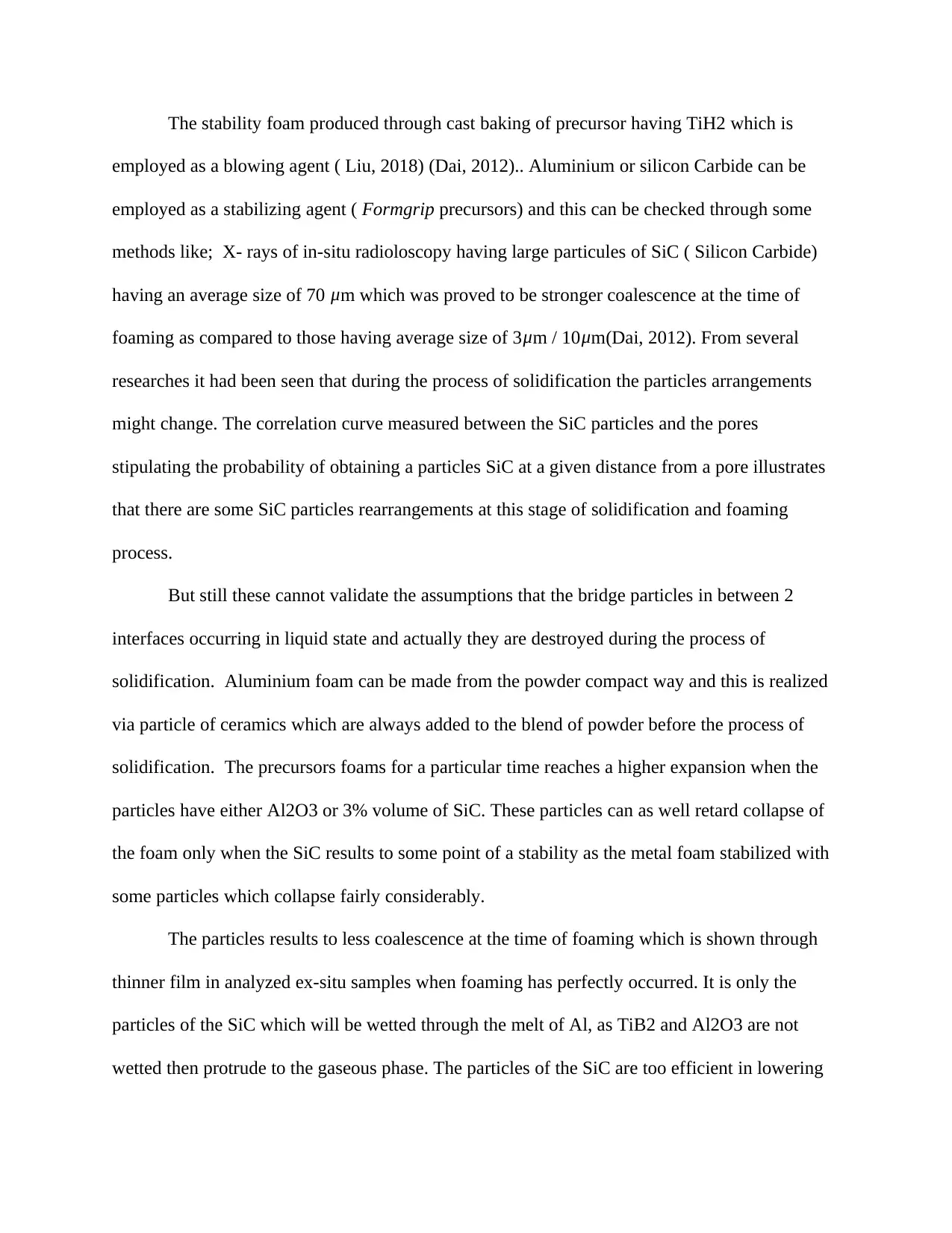
The stability foam produced through cast baking of precursor having TiH2 which is
employed as a blowing agent ( Liu, 2018) (Dai, 2012).. Aluminium or silicon Carbide can be
employed as a stabilizing agent ( Formgrip precursors) and this can be checked through some
methods like; X- rays of in-situ radioloscopy having large particules of SiC ( Silicon Carbide)
having an average size of 70 μm which was proved to be stronger coalescence at the time of
foaming as compared to those having average size of 3 μm / 10 μm(Dai, 2012). From several
researches it had been seen that during the process of solidification the particles arrangements
might change. The correlation curve measured between the SiC particles and the pores
stipulating the probability of obtaining a particles SiC at a given distance from a pore illustrates
that there are some SiC particles rearrangements at this stage of solidification and foaming
process.
But still these cannot validate the assumptions that the bridge particles in between 2
interfaces occurring in liquid state and actually they are destroyed during the process of
solidification. Aluminium foam can be made from the powder compact way and this is realized
via particle of ceramics which are always added to the blend of powder before the process of
solidification. The precursors foams for a particular time reaches a higher expansion when the
particles have either Al2O3 or 3% volume of SiC. These particles can as well retard collapse of
the foam only when the SiC results to some point of a stability as the metal foam stabilized with
some particles which collapse fairly considerably.
The particles results to less coalescence at the time of foaming which is shown through
thinner film in analyzed ex-situ samples when foaming has perfectly occurred. It is only the
particles of the SiC which will be wetted through the melt of Al, as TiB2 and Al2O3 are not
wetted then protrude to the gaseous phase. The particles of the SiC are too efficient in lowering
employed as a blowing agent ( Liu, 2018) (Dai, 2012).. Aluminium or silicon Carbide can be
employed as a stabilizing agent ( Formgrip precursors) and this can be checked through some
methods like; X- rays of in-situ radioloscopy having large particules of SiC ( Silicon Carbide)
having an average size of 70 μm which was proved to be stronger coalescence at the time of
foaming as compared to those having average size of 3 μm / 10 μm(Dai, 2012). From several
researches it had been seen that during the process of solidification the particles arrangements
might change. The correlation curve measured between the SiC particles and the pores
stipulating the probability of obtaining a particles SiC at a given distance from a pore illustrates
that there are some SiC particles rearrangements at this stage of solidification and foaming
process.
But still these cannot validate the assumptions that the bridge particles in between 2
interfaces occurring in liquid state and actually they are destroyed during the process of
solidification. Aluminium foam can be made from the powder compact way and this is realized
via particle of ceramics which are always added to the blend of powder before the process of
solidification. The precursors foams for a particular time reaches a higher expansion when the
particles have either Al2O3 or 3% volume of SiC. These particles can as well retard collapse of
the foam only when the SiC results to some point of a stability as the metal foam stabilized with
some particles which collapse fairly considerably.
The particles results to less coalescence at the time of foaming which is shown through
thinner film in analyzed ex-situ samples when foaming has perfectly occurred. It is only the
particles of the SiC which will be wetted through the melt of Al, as TiB2 and Al2O3 are not
wetted then protrude to the gaseous phase. The particles of the SiC are too efficient in lowering
Paraphrase This Document
Need a fresh take? Get an instant paraphrase of this document with our AI Paraphraser
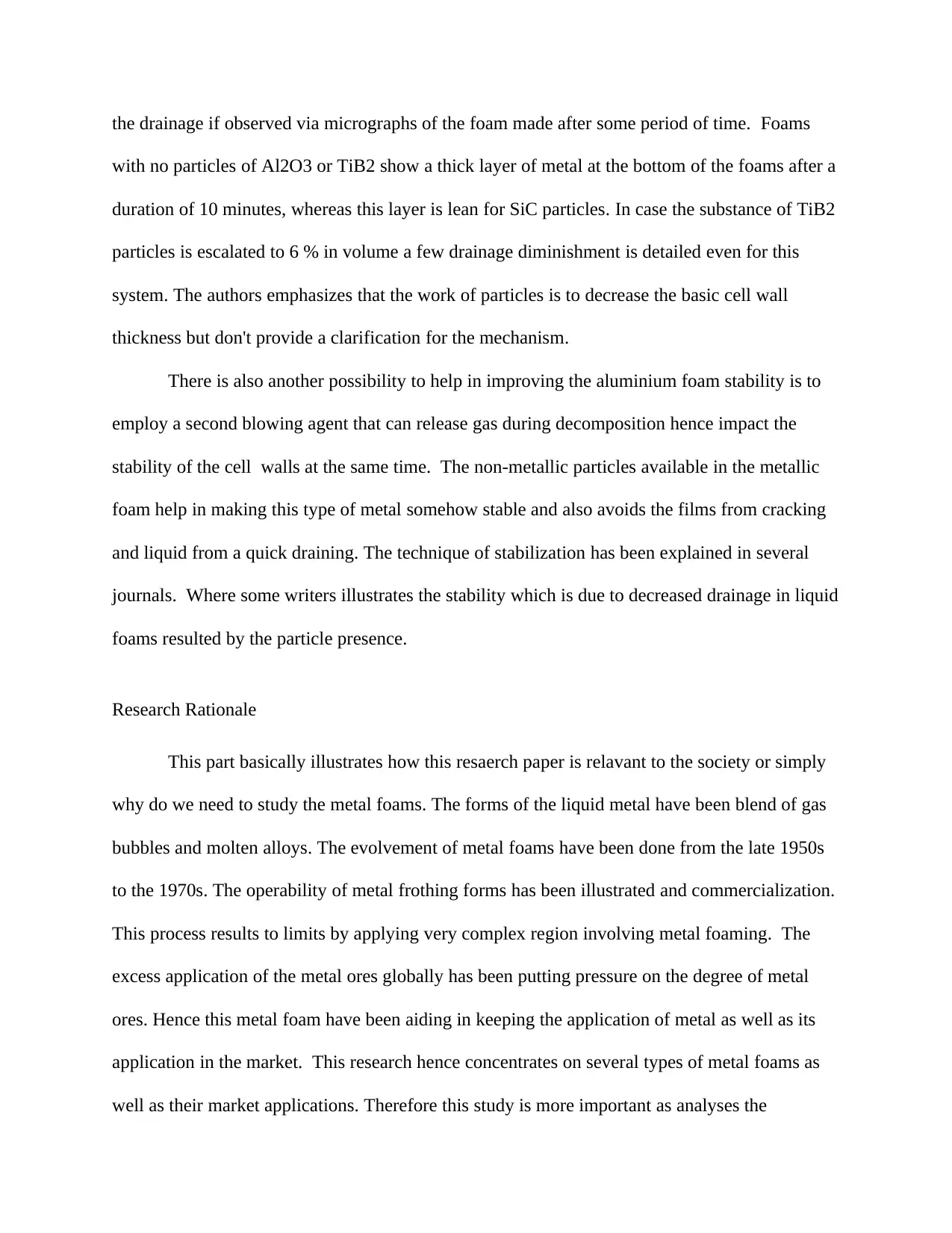
the drainage if observed via micrographs of the foam made after some period of time. Foams
with no particles of Al2O3 or TiB2 show a thick layer of metal at the bottom of the foams after a
duration of 10 minutes, whereas this layer is lean for SiC particles. In case the substance of TiB2
particles is escalated to 6 % in volume a few drainage diminishment is detailed even for this
system. The authors emphasizes that the work of particles is to decrease the basic cell wall
thickness but don't provide a clarification for the mechanism.
There is also another possibility to help in improving the aluminium foam stability is to
employ a second blowing agent that can release gas during decomposition hence impact the
stability of the cell walls at the same time. The non-metallic particles available in the metallic
foam help in making this type of metal somehow stable and also avoids the films from cracking
and liquid from a quick draining. The technique of stabilization has been explained in several
journals. Where some writers illustrates the stability which is due to decreased drainage in liquid
foams resulted by the particle presence.
Research Rationale
This part basically illustrates how this resaerch paper is relavant to the society or simply
why do we need to study the metal foams. The forms of the liquid metal have been blend of gas
bubbles and molten alloys. The evolvement of metal foams have been done from the late 1950s
to the 1970s. The operability of metal frothing forms has been illustrated and commercialization.
This process results to limits by applying very complex region involving metal foaming. The
excess application of the metal ores globally has been putting pressure on the degree of metal
ores. Hence this metal foam have been aiding in keeping the application of metal as well as its
application in the market. This research hence concentrates on several types of metal foams as
well as their market applications. Therefore this study is more important as analyses the
with no particles of Al2O3 or TiB2 show a thick layer of metal at the bottom of the foams after a
duration of 10 minutes, whereas this layer is lean for SiC particles. In case the substance of TiB2
particles is escalated to 6 % in volume a few drainage diminishment is detailed even for this
system. The authors emphasizes that the work of particles is to decrease the basic cell wall
thickness but don't provide a clarification for the mechanism.
There is also another possibility to help in improving the aluminium foam stability is to
employ a second blowing agent that can release gas during decomposition hence impact the
stability of the cell walls at the same time. The non-metallic particles available in the metallic
foam help in making this type of metal somehow stable and also avoids the films from cracking
and liquid from a quick draining. The technique of stabilization has been explained in several
journals. Where some writers illustrates the stability which is due to decreased drainage in liquid
foams resulted by the particle presence.
Research Rationale
This part basically illustrates how this resaerch paper is relavant to the society or simply
why do we need to study the metal foams. The forms of the liquid metal have been blend of gas
bubbles and molten alloys. The evolvement of metal foams have been done from the late 1950s
to the 1970s. The operability of metal frothing forms has been illustrated and commercialization.
This process results to limits by applying very complex region involving metal foaming. The
excess application of the metal ores globally has been putting pressure on the degree of metal
ores. Hence this metal foam have been aiding in keeping the application of metal as well as its
application in the market. This research hence concentrates on several types of metal foams as
well as their market applications. Therefore this study is more important as analyses the
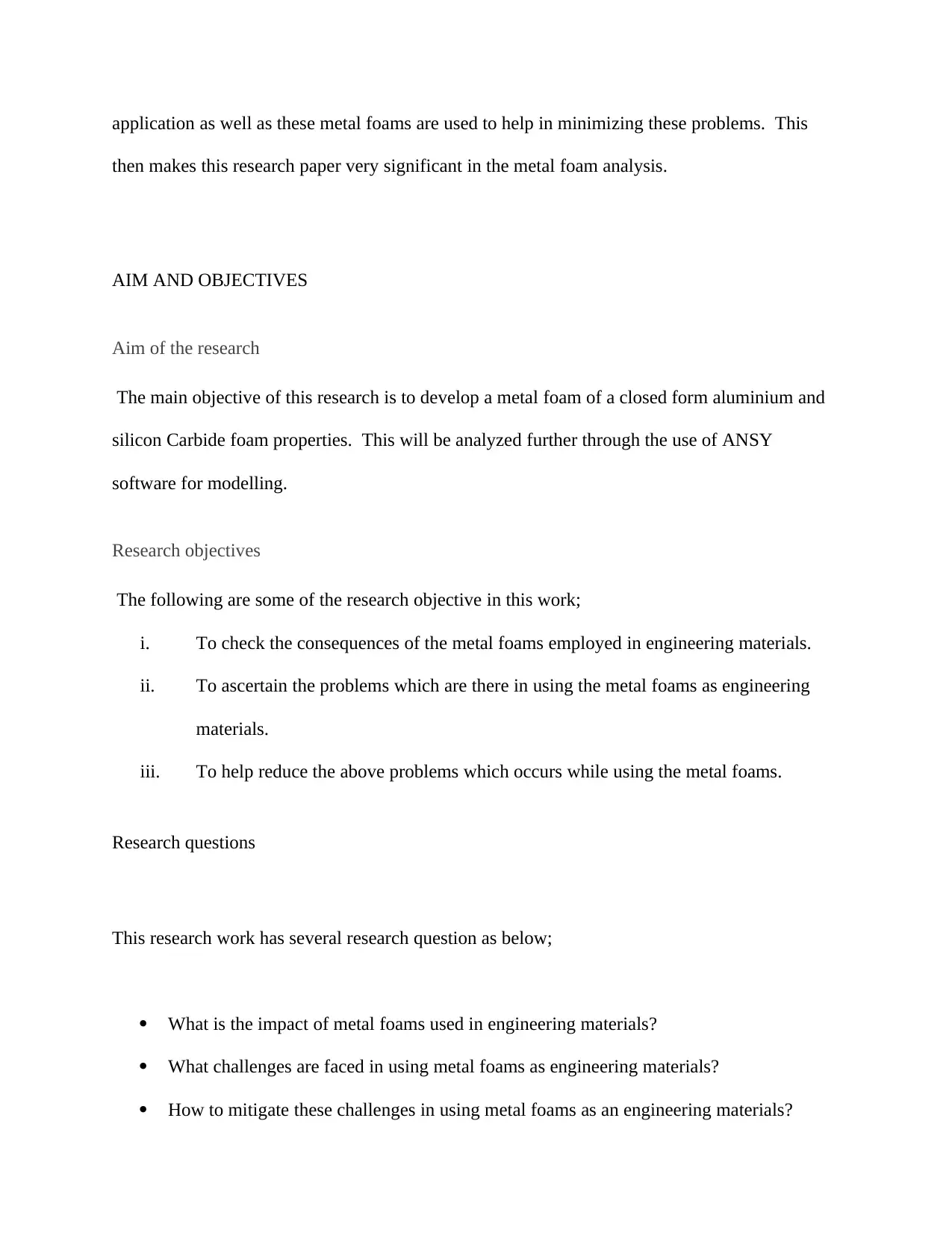
application as well as these metal foams are used to help in minimizing these problems. This
then makes this research paper very significant in the metal foam analysis.
AIM AND OBJECTIVES
Aim of the research
The main objective of this research is to develop a metal foam of a closed form aluminium and
silicon Carbide foam properties. This will be analyzed further through the use of ANSY
software for modelling.
Research objectives
The following are some of the research objective in this work;
i. To check the consequences of the metal foams employed in engineering materials.
ii. To ascertain the problems which are there in using the metal foams as engineering
materials.
iii. To help reduce the above problems which occurs while using the metal foams.
Research questions
This research work has several research question as below;
What is the impact of metal foams used in engineering materials?
What challenges are faced in using metal foams as engineering materials?
How to mitigate these challenges in using metal foams as an engineering materials?
then makes this research paper very significant in the metal foam analysis.
AIM AND OBJECTIVES
Aim of the research
The main objective of this research is to develop a metal foam of a closed form aluminium and
silicon Carbide foam properties. This will be analyzed further through the use of ANSY
software for modelling.
Research objectives
The following are some of the research objective in this work;
i. To check the consequences of the metal foams employed in engineering materials.
ii. To ascertain the problems which are there in using the metal foams as engineering
materials.
iii. To help reduce the above problems which occurs while using the metal foams.
Research questions
This research work has several research question as below;
What is the impact of metal foams used in engineering materials?
What challenges are faced in using metal foams as engineering materials?
How to mitigate these challenges in using metal foams as an engineering materials?
⊘ This is a preview!⊘
Do you want full access?
Subscribe today to unlock all pages.

Trusted by 1+ million students worldwide
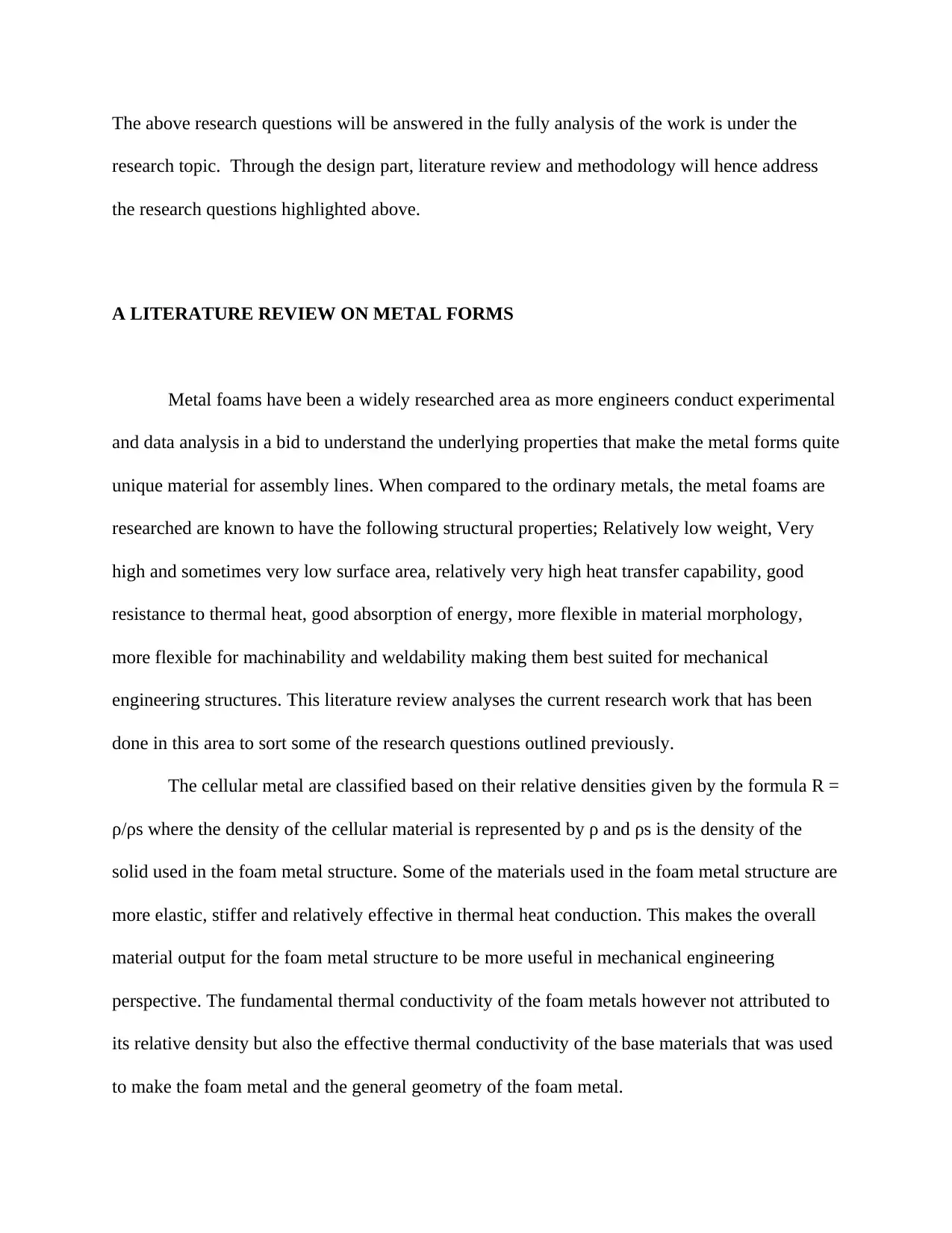
The above research questions will be answered in the fully analysis of the work is under the
research topic. Through the design part, literature review and methodology will hence address
the research questions highlighted above.
A LITERATURE REVIEW ON METAL FORMS
Metal foams have been a widely researched area as more engineers conduct experimental
and data analysis in a bid to understand the underlying properties that make the metal forms quite
unique material for assembly lines. When compared to the ordinary metals, the metal foams are
researched are known to have the following structural properties; Relatively low weight, Very
high and sometimes very low surface area, relatively very high heat transfer capability, good
resistance to thermal heat, good absorption of energy, more flexible in material morphology,
more flexible for machinability and weldability making them best suited for mechanical
engineering structures. This literature review analyses the current research work that has been
done in this area to sort some of the research questions outlined previously.
The cellular metal are classified based on their relative densities given by the formula R =
ρ/ρs where the density of the cellular material is represented by ρ and ρs is the density of the
solid used in the foam metal structure. Some of the materials used in the foam metal structure are
more elastic, stiffer and relatively effective in thermal heat conduction. This makes the overall
material output for the foam metal structure to be more useful in mechanical engineering
perspective. The fundamental thermal conductivity of the foam metals however not attributed to
its relative density but also the effective thermal conductivity of the base materials that was used
to make the foam metal and the general geometry of the foam metal.
research topic. Through the design part, literature review and methodology will hence address
the research questions highlighted above.
A LITERATURE REVIEW ON METAL FORMS
Metal foams have been a widely researched area as more engineers conduct experimental
and data analysis in a bid to understand the underlying properties that make the metal forms quite
unique material for assembly lines. When compared to the ordinary metals, the metal foams are
researched are known to have the following structural properties; Relatively low weight, Very
high and sometimes very low surface area, relatively very high heat transfer capability, good
resistance to thermal heat, good absorption of energy, more flexible in material morphology,
more flexible for machinability and weldability making them best suited for mechanical
engineering structures. This literature review analyses the current research work that has been
done in this area to sort some of the research questions outlined previously.
The cellular metal are classified based on their relative densities given by the formula R =
ρ/ρs where the density of the cellular material is represented by ρ and ρs is the density of the
solid used in the foam metal structure. Some of the materials used in the foam metal structure are
more elastic, stiffer and relatively effective in thermal heat conduction. This makes the overall
material output for the foam metal structure to be more useful in mechanical engineering
perspective. The fundamental thermal conductivity of the foam metals however not attributed to
its relative density but also the effective thermal conductivity of the base materials that was used
to make the foam metal and the general geometry of the foam metal.
Paraphrase This Document
Need a fresh take? Get an instant paraphrase of this document with our AI Paraphraser
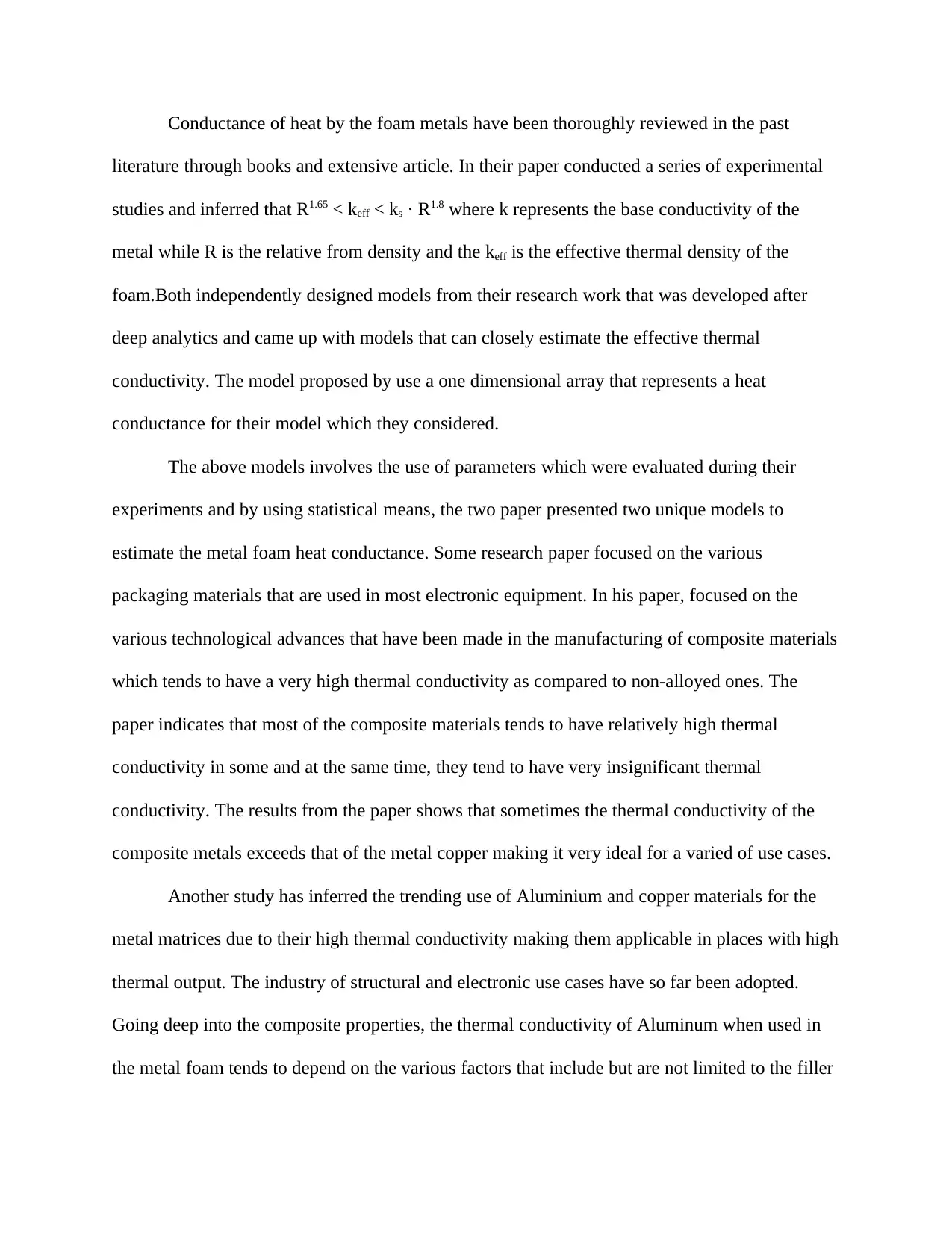
Conductance of heat by the foam metals have been thoroughly reviewed in the past
literature through books and extensive article. In their paper conducted a series of experimental
studies and inferred that R1.65 < keff < ks · R1.8 where k represents the base conductivity of the
metal while R is the relative from density and the keff is the effective thermal density of the
foam.Both independently designed models from their research work that was developed after
deep analytics and came up with models that can closely estimate the effective thermal
conductivity. The model proposed by use a one dimensional array that represents a heat
conductance for their model which they considered.
The above models involves the use of parameters which were evaluated during their
experiments and by using statistical means, the two paper presented two unique models to
estimate the metal foam heat conductance. Some research paper focused on the various
packaging materials that are used in most electronic equipment. In his paper, focused on the
various technological advances that have been made in the manufacturing of composite materials
which tends to have a very high thermal conductivity as compared to non-alloyed ones. The
paper indicates that most of the composite materials tends to have relatively high thermal
conductivity in some and at the same time, they tend to have very insignificant thermal
conductivity. The results from the paper shows that sometimes the thermal conductivity of the
composite metals exceeds that of the metal copper making it very ideal for a varied of use cases.
Another study has inferred the trending use of Aluminium and copper materials for the
metal matrices due to their high thermal conductivity making them applicable in places with high
thermal output. The industry of structural and electronic use cases have so far been adopted.
Going deep into the composite properties, the thermal conductivity of Aluminum when used in
the metal foam tends to depend on the various factors that include but are not limited to the filler
literature through books and extensive article. In their paper conducted a series of experimental
studies and inferred that R1.65 < keff < ks · R1.8 where k represents the base conductivity of the
metal while R is the relative from density and the keff is the effective thermal density of the
foam.Both independently designed models from their research work that was developed after
deep analytics and came up with models that can closely estimate the effective thermal
conductivity. The model proposed by use a one dimensional array that represents a heat
conductance for their model which they considered.
The above models involves the use of parameters which were evaluated during their
experiments and by using statistical means, the two paper presented two unique models to
estimate the metal foam heat conductance. Some research paper focused on the various
packaging materials that are used in most electronic equipment. In his paper, focused on the
various technological advances that have been made in the manufacturing of composite materials
which tends to have a very high thermal conductivity as compared to non-alloyed ones. The
paper indicates that most of the composite materials tends to have relatively high thermal
conductivity in some and at the same time, they tend to have very insignificant thermal
conductivity. The results from the paper shows that sometimes the thermal conductivity of the
composite metals exceeds that of the metal copper making it very ideal for a varied of use cases.
Another study has inferred the trending use of Aluminium and copper materials for the
metal matrices due to their high thermal conductivity making them applicable in places with high
thermal output. The industry of structural and electronic use cases have so far been adopted.
Going deep into the composite properties, the thermal conductivity of Aluminum when used in
the metal foam tends to depend on the various factors that include but are not limited to the filler
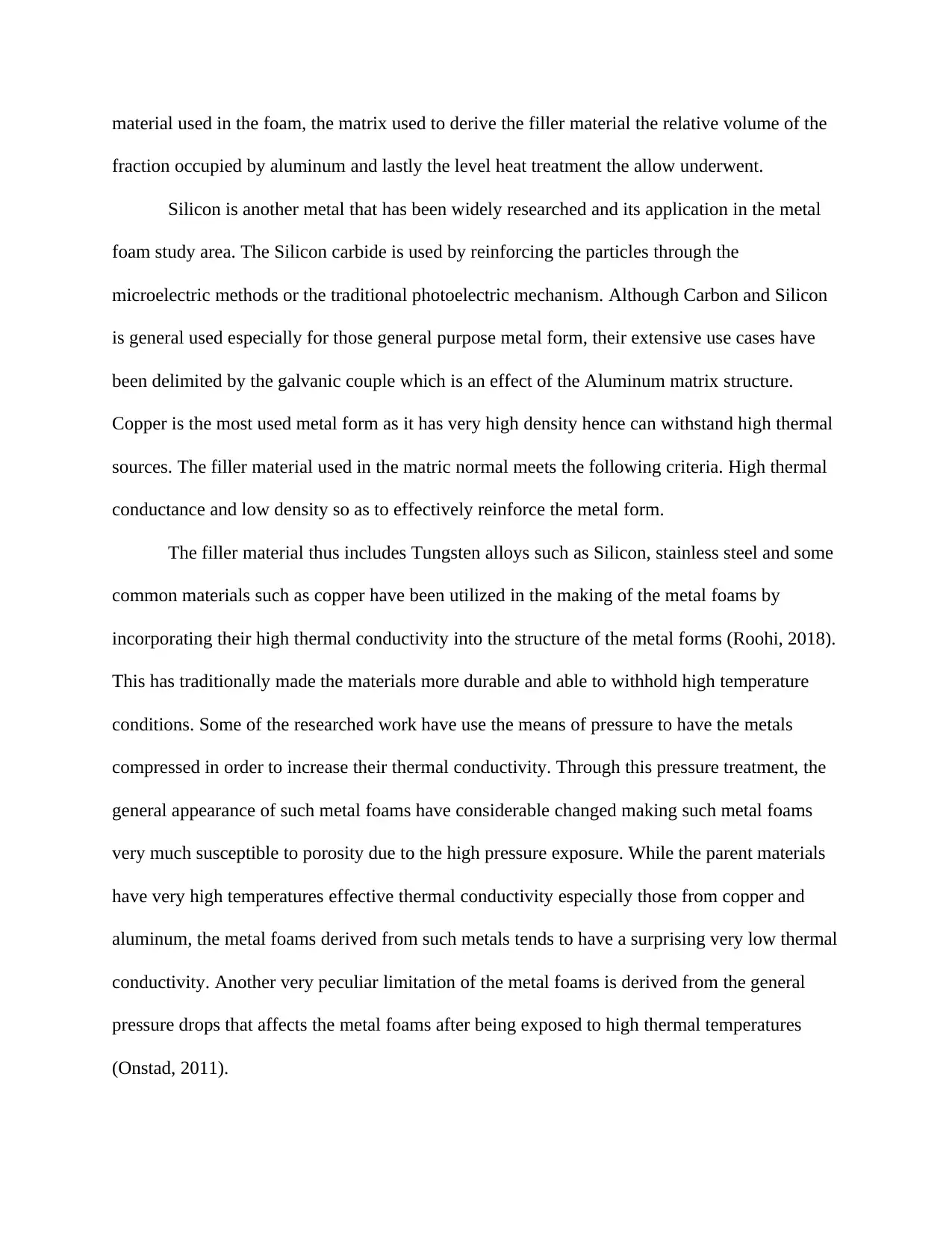
material used in the foam, the matrix used to derive the filler material the relative volume of the
fraction occupied by aluminum and lastly the level heat treatment the allow underwent.
Silicon is another metal that has been widely researched and its application in the metal
foam study area. The Silicon carbide is used by reinforcing the particles through the
microelectric methods or the traditional photoelectric mechanism. Although Carbon and Silicon
is general used especially for those general purpose metal form, their extensive use cases have
been delimited by the galvanic couple which is an effect of the Aluminum matrix structure.
Copper is the most used metal form as it has very high density hence can withstand high thermal
sources. The filler material used in the matric normal meets the following criteria. High thermal
conductance and low density so as to effectively reinforce the metal form.
The filler material thus includes Tungsten alloys such as Silicon, stainless steel and some
common materials such as copper have been utilized in the making of the metal foams by
incorporating their high thermal conductivity into the structure of the metal forms (Roohi, 2018).
This has traditionally made the materials more durable and able to withhold high temperature
conditions. Some of the researched work have use the means of pressure to have the metals
compressed in order to increase their thermal conductivity. Through this pressure treatment, the
general appearance of such metal foams have considerable changed making such metal foams
very much susceptible to porosity due to the high pressure exposure. While the parent materials
have very high temperatures effective thermal conductivity especially those from copper and
aluminum, the metal foams derived from such metals tends to have a surprising very low thermal
conductivity. Another very peculiar limitation of the metal foams is derived from the general
pressure drops that affects the metal foams after being exposed to high thermal temperatures
(Onstad, 2011).
fraction occupied by aluminum and lastly the level heat treatment the allow underwent.
Silicon is another metal that has been widely researched and its application in the metal
foam study area. The Silicon carbide is used by reinforcing the particles through the
microelectric methods or the traditional photoelectric mechanism. Although Carbon and Silicon
is general used especially for those general purpose metal form, their extensive use cases have
been delimited by the galvanic couple which is an effect of the Aluminum matrix structure.
Copper is the most used metal form as it has very high density hence can withstand high thermal
sources. The filler material used in the matric normal meets the following criteria. High thermal
conductance and low density so as to effectively reinforce the metal form.
The filler material thus includes Tungsten alloys such as Silicon, stainless steel and some
common materials such as copper have been utilized in the making of the metal foams by
incorporating their high thermal conductivity into the structure of the metal forms (Roohi, 2018).
This has traditionally made the materials more durable and able to withhold high temperature
conditions. Some of the researched work have use the means of pressure to have the metals
compressed in order to increase their thermal conductivity. Through this pressure treatment, the
general appearance of such metal foams have considerable changed making such metal foams
very much susceptible to porosity due to the high pressure exposure. While the parent materials
have very high temperatures effective thermal conductivity especially those from copper and
aluminum, the metal foams derived from such metals tends to have a surprising very low thermal
conductivity. Another very peculiar limitation of the metal foams is derived from the general
pressure drops that affects the metal foams after being exposed to high thermal temperatures
(Onstad, 2011).
⊘ This is a preview!⊘
Do you want full access?
Subscribe today to unlock all pages.

Trusted by 1+ million students worldwide
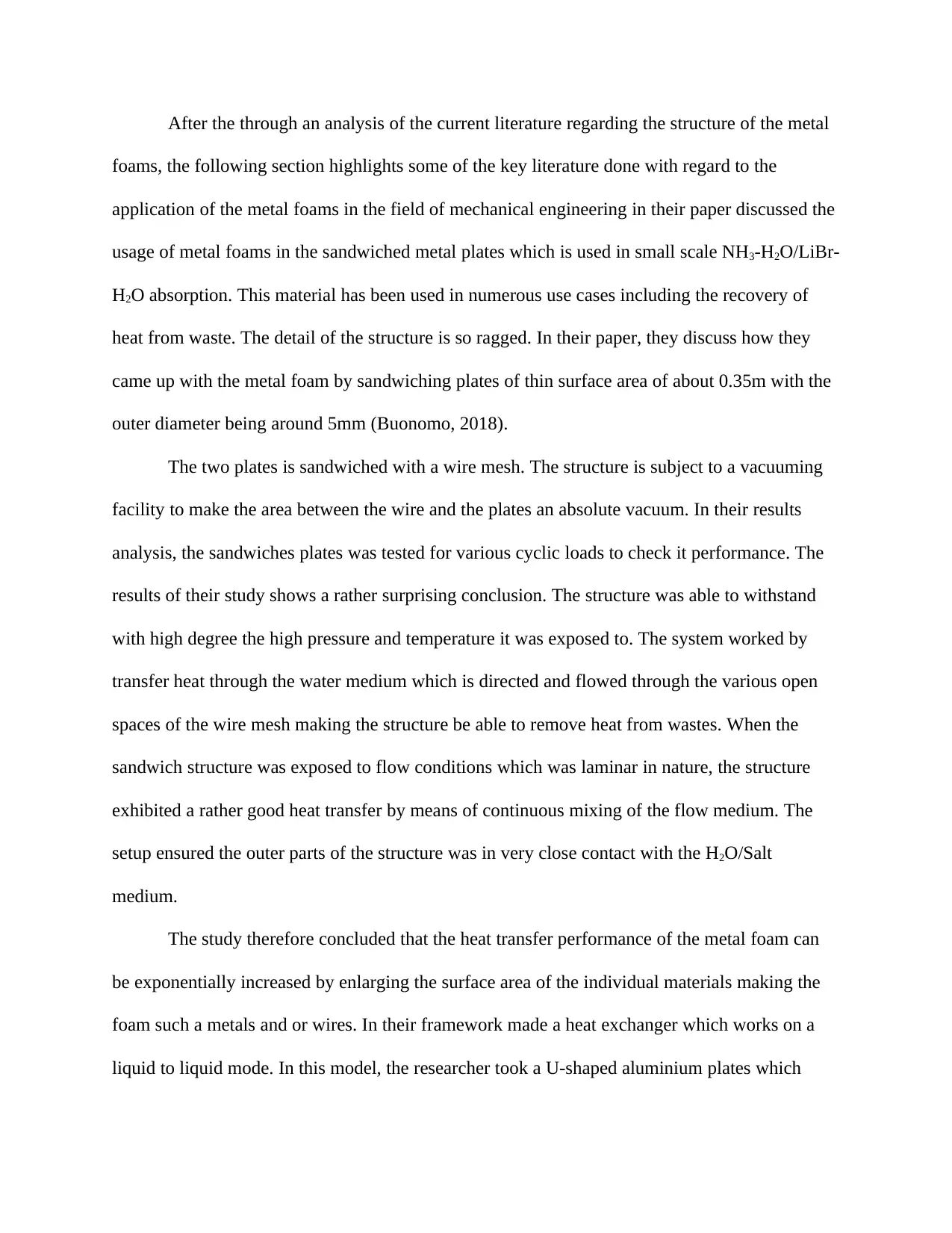
After the through an analysis of the current literature regarding the structure of the metal
foams, the following section highlights some of the key literature done with regard to the
application of the metal foams in the field of mechanical engineering in their paper discussed the
usage of metal foams in the sandwiched metal plates which is used in small scale NH3-H2O/LiBr-
H2O absorption. This material has been used in numerous use cases including the recovery of
heat from waste. The detail of the structure is so ragged. In their paper, they discuss how they
came up with the metal foam by sandwiching plates of thin surface area of about 0.35m with the
outer diameter being around 5mm (Buonomo, 2018).
The two plates is sandwiched with a wire mesh. The structure is subject to a vacuuming
facility to make the area between the wire and the plates an absolute vacuum. In their results
analysis, the sandwiches plates was tested for various cyclic loads to check it performance. The
results of their study shows a rather surprising conclusion. The structure was able to withstand
with high degree the high pressure and temperature it was exposed to. The system worked by
transfer heat through the water medium which is directed and flowed through the various open
spaces of the wire mesh making the structure be able to remove heat from wastes. When the
sandwich structure was exposed to flow conditions which was laminar in nature, the structure
exhibited a rather good heat transfer by means of continuous mixing of the flow medium. The
setup ensured the outer parts of the structure was in very close contact with the H2O/Salt
medium.
The study therefore concluded that the heat transfer performance of the metal foam can
be exponentially increased by enlarging the surface area of the individual materials making the
foam such a metals and or wires. In their framework made a heat exchanger which works on a
liquid to liquid mode. In this model, the researcher took a U-shaped aluminium plates which
foams, the following section highlights some of the key literature done with regard to the
application of the metal foams in the field of mechanical engineering in their paper discussed the
usage of metal foams in the sandwiched metal plates which is used in small scale NH3-H2O/LiBr-
H2O absorption. This material has been used in numerous use cases including the recovery of
heat from waste. The detail of the structure is so ragged. In their paper, they discuss how they
came up with the metal foam by sandwiching plates of thin surface area of about 0.35m with the
outer diameter being around 5mm (Buonomo, 2018).
The two plates is sandwiched with a wire mesh. The structure is subject to a vacuuming
facility to make the area between the wire and the plates an absolute vacuum. In their results
analysis, the sandwiches plates was tested for various cyclic loads to check it performance. The
results of their study shows a rather surprising conclusion. The structure was able to withstand
with high degree the high pressure and temperature it was exposed to. The system worked by
transfer heat through the water medium which is directed and flowed through the various open
spaces of the wire mesh making the structure be able to remove heat from wastes. When the
sandwich structure was exposed to flow conditions which was laminar in nature, the structure
exhibited a rather good heat transfer by means of continuous mixing of the flow medium. The
setup ensured the outer parts of the structure was in very close contact with the H2O/Salt
medium.
The study therefore concluded that the heat transfer performance of the metal foam can
be exponentially increased by enlarging the surface area of the individual materials making the
foam such a metals and or wires. In their framework made a heat exchanger which works on a
liquid to liquid mode. In this model, the researcher took a U-shaped aluminium plates which
Paraphrase This Document
Need a fresh take? Get an instant paraphrase of this document with our AI Paraphraser
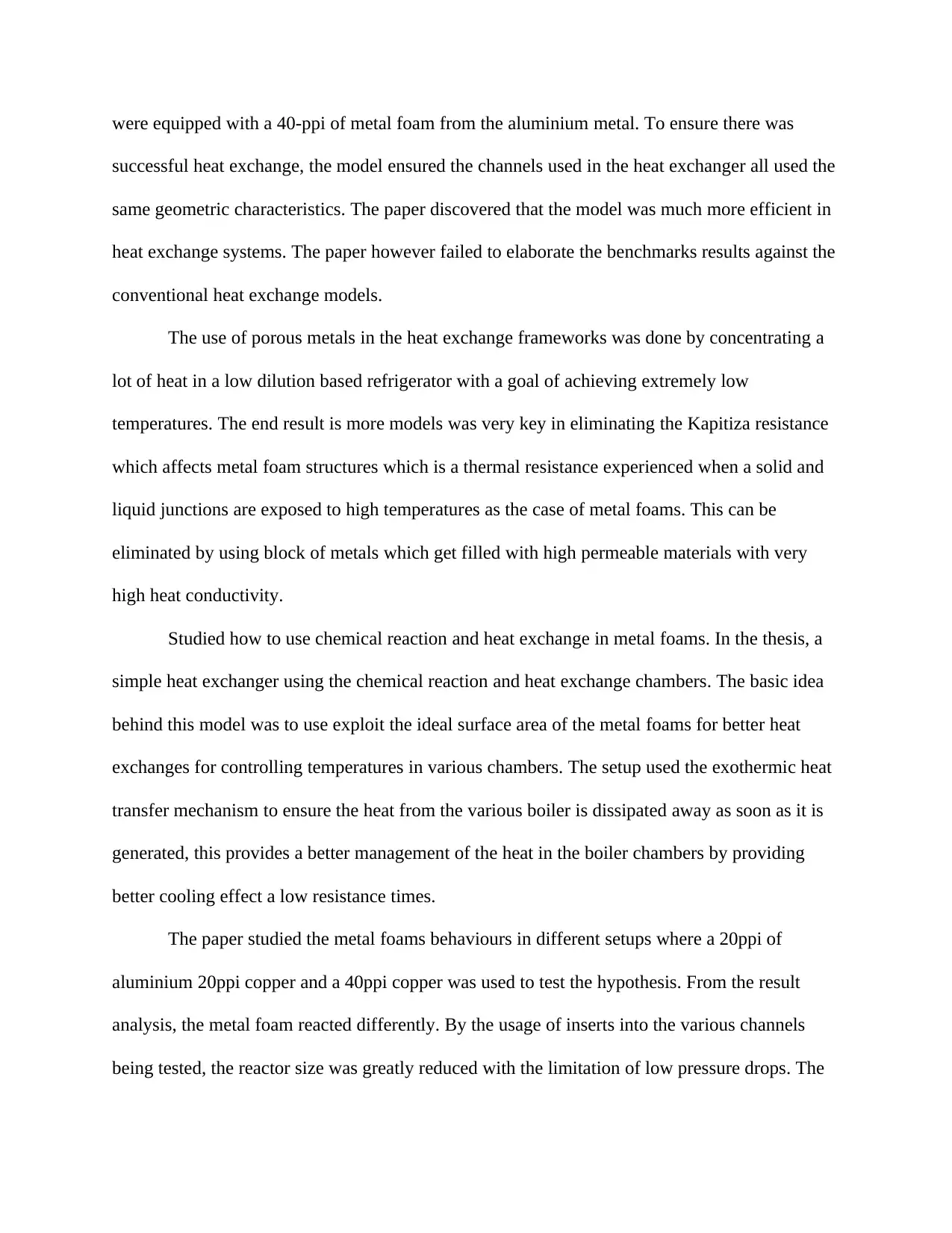
were equipped with a 40-ppi of metal foam from the aluminium metal. To ensure there was
successful heat exchange, the model ensured the channels used in the heat exchanger all used the
same geometric characteristics. The paper discovered that the model was much more efficient in
heat exchange systems. The paper however failed to elaborate the benchmarks results against the
conventional heat exchange models.
The use of porous metals in the heat exchange frameworks was done by concentrating a
lot of heat in a low dilution based refrigerator with a goal of achieving extremely low
temperatures. The end result is more models was very key in eliminating the Kapitiza resistance
which affects metal foam structures which is a thermal resistance experienced when a solid and
liquid junctions are exposed to high temperatures as the case of metal foams. This can be
eliminated by using block of metals which get filled with high permeable materials with very
high heat conductivity.
Studied how to use chemical reaction and heat exchange in metal foams. In the thesis, a
simple heat exchanger using the chemical reaction and heat exchange chambers. The basic idea
behind this model was to use exploit the ideal surface area of the metal foams for better heat
exchanges for controlling temperatures in various chambers. The setup used the exothermic heat
transfer mechanism to ensure the heat from the various boiler is dissipated away as soon as it is
generated, this provides a better management of the heat in the boiler chambers by providing
better cooling effect a low resistance times.
The paper studied the metal foams behaviours in different setups where a 20ppi of
aluminium 20ppi copper and a 40ppi copper was used to test the hypothesis. From the result
analysis, the metal foam reacted differently. By the usage of inserts into the various channels
being tested, the reactor size was greatly reduced with the limitation of low pressure drops. The
successful heat exchange, the model ensured the channels used in the heat exchanger all used the
same geometric characteristics. The paper discovered that the model was much more efficient in
heat exchange systems. The paper however failed to elaborate the benchmarks results against the
conventional heat exchange models.
The use of porous metals in the heat exchange frameworks was done by concentrating a
lot of heat in a low dilution based refrigerator with a goal of achieving extremely low
temperatures. The end result is more models was very key in eliminating the Kapitiza resistance
which affects metal foam structures which is a thermal resistance experienced when a solid and
liquid junctions are exposed to high temperatures as the case of metal foams. This can be
eliminated by using block of metals which get filled with high permeable materials with very
high heat conductivity.
Studied how to use chemical reaction and heat exchange in metal foams. In the thesis, a
simple heat exchanger using the chemical reaction and heat exchange chambers. The basic idea
behind this model was to use exploit the ideal surface area of the metal foams for better heat
exchanges for controlling temperatures in various chambers. The setup used the exothermic heat
transfer mechanism to ensure the heat from the various boiler is dissipated away as soon as it is
generated, this provides a better management of the heat in the boiler chambers by providing
better cooling effect a low resistance times.
The paper studied the metal foams behaviours in different setups where a 20ppi of
aluminium 20ppi copper and a 40ppi copper was used to test the hypothesis. From the result
analysis, the metal foam reacted differently. By the usage of inserts into the various channels
being tested, the reactor size was greatly reduced with the limitation of low pressure drops. The
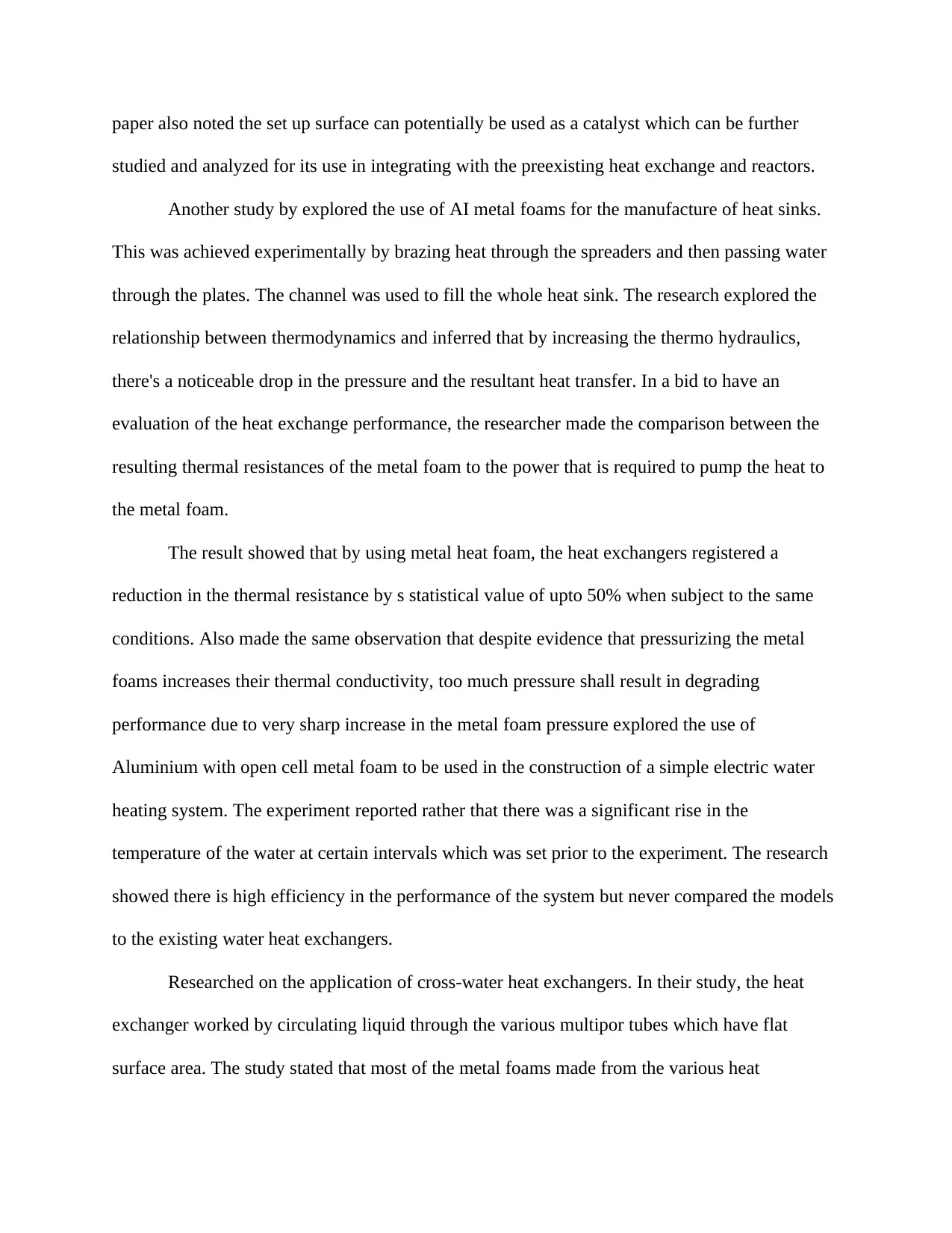
paper also noted the set up surface can potentially be used as a catalyst which can be further
studied and analyzed for its use in integrating with the preexisting heat exchange and reactors.
Another study by explored the use of AI metal foams for the manufacture of heat sinks.
This was achieved experimentally by brazing heat through the spreaders and then passing water
through the plates. The channel was used to fill the whole heat sink. The research explored the
relationship between thermodynamics and inferred that by increasing the thermo hydraulics,
there's a noticeable drop in the pressure and the resultant heat transfer. In a bid to have an
evaluation of the heat exchange performance, the researcher made the comparison between the
resulting thermal resistances of the metal foam to the power that is required to pump the heat to
the metal foam.
The result showed that by using metal heat foam, the heat exchangers registered a
reduction in the thermal resistance by s statistical value of upto 50% when subject to the same
conditions. Also made the same observation that despite evidence that pressurizing the metal
foams increases their thermal conductivity, too much pressure shall result in degrading
performance due to very sharp increase in the metal foam pressure explored the use of
Aluminium with open cell metal foam to be used in the construction of a simple electric water
heating system. The experiment reported rather that there was a significant rise in the
temperature of the water at certain intervals which was set prior to the experiment. The research
showed there is high efficiency in the performance of the system but never compared the models
to the existing water heat exchangers.
Researched on the application of cross-water heat exchangers. In their study, the heat
exchanger worked by circulating liquid through the various multipor tubes which have flat
surface area. The study stated that most of the metal foams made from the various heat
studied and analyzed for its use in integrating with the preexisting heat exchange and reactors.
Another study by explored the use of AI metal foams for the manufacture of heat sinks.
This was achieved experimentally by brazing heat through the spreaders and then passing water
through the plates. The channel was used to fill the whole heat sink. The research explored the
relationship between thermodynamics and inferred that by increasing the thermo hydraulics,
there's a noticeable drop in the pressure and the resultant heat transfer. In a bid to have an
evaluation of the heat exchange performance, the researcher made the comparison between the
resulting thermal resistances of the metal foam to the power that is required to pump the heat to
the metal foam.
The result showed that by using metal heat foam, the heat exchangers registered a
reduction in the thermal resistance by s statistical value of upto 50% when subject to the same
conditions. Also made the same observation that despite evidence that pressurizing the metal
foams increases their thermal conductivity, too much pressure shall result in degrading
performance due to very sharp increase in the metal foam pressure explored the use of
Aluminium with open cell metal foam to be used in the construction of a simple electric water
heating system. The experiment reported rather that there was a significant rise in the
temperature of the water at certain intervals which was set prior to the experiment. The research
showed there is high efficiency in the performance of the system but never compared the models
to the existing water heat exchangers.
Researched on the application of cross-water heat exchangers. In their study, the heat
exchanger worked by circulating liquid through the various multipor tubes which have flat
surface area. The study stated that most of the metal foams made from the various heat
⊘ This is a preview!⊘
Do you want full access?
Subscribe today to unlock all pages.

Trusted by 1+ million students worldwide
1 out of 22
Related Documents
Your All-in-One AI-Powered Toolkit for Academic Success.
+13062052269
info@desklib.com
Available 24*7 on WhatsApp / Email
![[object Object]](/_next/static/media/star-bottom.7253800d.svg)
Unlock your academic potential
Copyright © 2020–2025 A2Z Services. All Rights Reserved. Developed and managed by ZUCOL.



